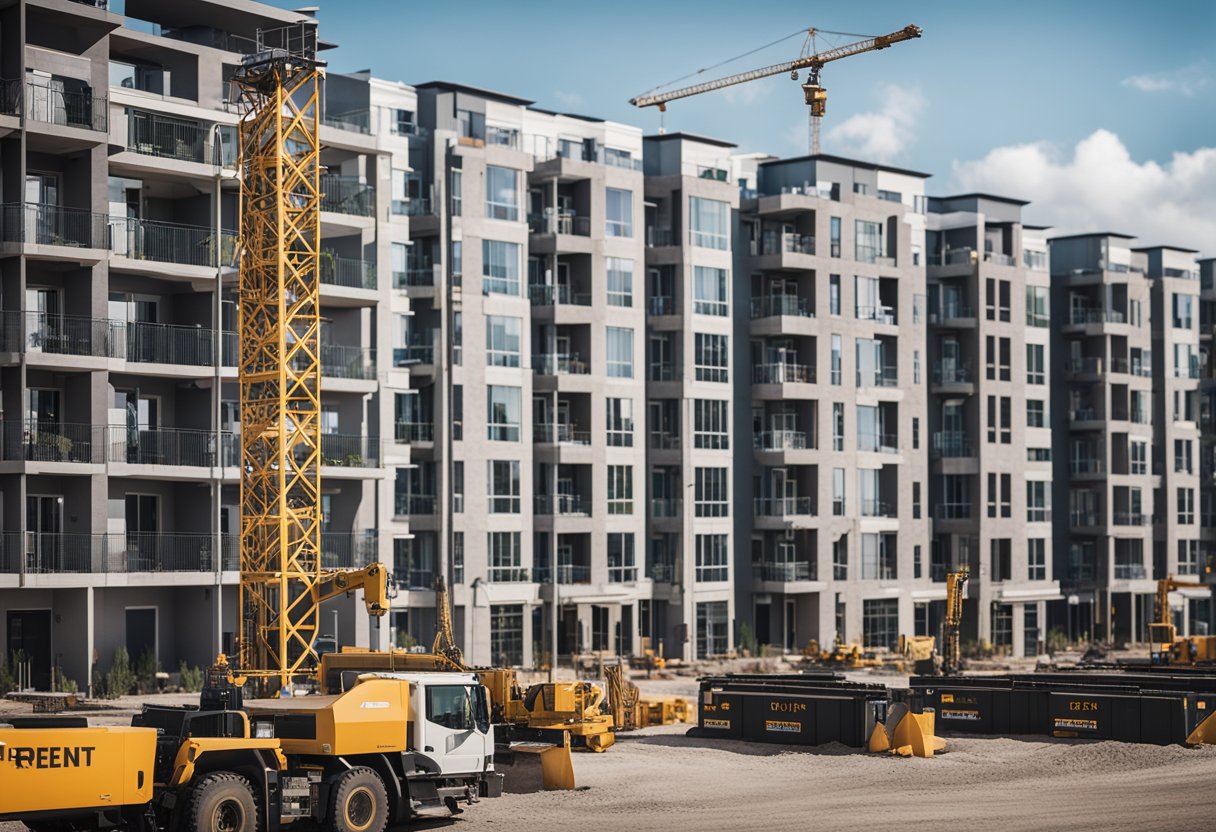The rental market continues to evolve in 2025, shaped by shifting demographics and economic conditions. Rental prices have climbed 34.7% since pre-pandemic levels, creating both challenges for tenants and opportunities for investors in this dynamic landscape.
The North American rental market is projected to grow at a more moderate pace of 3.6% through 2025, offering strategic opportunities for investors who understand current market dynamics and adapt their portfolios accordingly. The construction and industrial sectors show particular promise, while short-term rental supply has expanded by 53% since 2022.
Your success in the rental market depends on recognizing emerging trends and positioning your investments to capitalize on regional growth patterns. With rent growth returning to historical averages of 3.5%, understanding where and how to invest becomes crucial for maximizing returns.
Key Takeaways
- Rental market growth is stabilizing at 3.6% in 2025, creating sustainable investment opportunities
- Property diversification across different rental sectors helps minimize risk while maximizing returns
- Strategic market selection and premium amenities drive higher rental yields in today’s competitive landscape
The Record-Breaking Rental Market Growth Expansion
The rental market has experienced unprecedented expansion, with rent growth reaching 4.1% year-over-year in key metropolitan areas. Your rental options now span a broader spectrum than ever before, reflecting the market’s dynamic evolution.
Single-family rental homes now command prices 20% higher than apartments, with rates soaring 41% above pre-pandemic levels. You’ll find multifamily units have also seen substantial increases, rising 26% during the same period.
The market has demonstrated remarkable resilience, with lease renewal rates climbing 6% to reach 68.9%. This trend indicates strong tenant retention and market stability.
Property managers are adapting to changing market conditions through strategic pricing. You’ll notice that vacancy rates and rent prices maintain a delicate balance, as operators carefully weigh occupancy against revenue optimization.
Key Market Indicators:
- Sustained annual growth in rental household formation
- Increasing preference for flexible living arrangements
- Strong performance in both urban and suburban markets
- Rising demand across various property types
The vacation rental segment has shown particular strength, driven by the revival of tourism and business travel. Your rental choices now extend beyond traditional long-term leases to include short-term and flexible arrangements.
Why Renters Are Choosing To Rent In 2025
More Americans are choosing to rent than ever before, with both young professionals and those over 50 embracing rental living.
You’ll find that flexibility is a key factor in this shift. The ability to relocate easily for career opportunities or lifestyle changes has become increasingly valuable, especially with the rise of remote work opportunities.
Rental demand continues to climb as people move from expensive cities to more affordable areas. Many are seeking larger spaces and better value for their money.
The current economic landscape has influenced housing choices significantly. With high mortgage rates and home prices, many potential buyers find renting more financially practical for their immediate needs.
High-quality rental homes are particularly appealing. Modern renters prioritize:
- Premium amenities
- Flexible lease terms
- Professional property management
- Well-maintained properties
- Smart home features
Urban areas are experiencing changes in rental patterns. Many renters now seek homes in suburbs and smaller cities, where they can find more space and better work-life balance.
The rental market appeals to different demographics for varying reasons:
Young Professionals:
- Career mobility
- Lower upfront costs
- Access to prime locations
50+ Age Group:
- Reduced maintenance responsibilities
- Community amenities
- Lock-and-leave lifestyle
Multifamily Vs Single-Family Rental Opportunities
Recent data shows single-family rental rates growing 41% since 2020, significantly outpacing multifamily units.
When choosing between rental property types, you’ll find that multifamily properties offer stronger cash flow potential due to multiple income streams from a single location.
The apartment sector has experienced unprecedented growth with 591,600 new units completed in major markets. This surge in supply has led to more competitive rental rates in dense urban areas.
Build-to-rent communities represent an emerging trend in the single-family home segment. These purpose-built neighborhoods combine the privacy of single-family living with professional property management.
Single-family rentals have shown consistent growth, attracting both traditional renters and those seeking more space. Property owners can expect less tenant turnover in single-family homes.
Market dynamics vary significantly by region:
- Northeast: High multifamily demand
- Sunbelt: Strong single-family rental growth
- West Coast: Mixed market with both sectors competing
- Midwest: Affordable single-family opportunities
Your investment choice should consider local market conditions, management requirements, and target tenant demographics.
Premium Rental Strategies That Maximize ROI
Smart home technology integration sets premium properties apart. Installing automated systems for lighting, security, and climate control attracts tech-savvy tenants willing to pay higher rents.
Luxury amenities like private workspaces, high-end fitness centers, and rooftop entertainment areas create compelling value propositions. Your property can command 15-25% higher rents by offering these premium features that appeal to young professionals.
Professional property management services streamline operations and enhance tenant experiences. A well-trained management team ensures prompt maintenance, concierge services, and digital rent collection.
Focus on creating Instagram-worthy common spaces and units. Modern design elements, premium appliances, and high-end finishes attract image-conscious renters who prioritize lifestyle over ownership.
Location analysis tools help identify emerging upscale neighborhoods. Investing in high-demand areas near employment hubs, universities, and cultural attractions ensures sustained tenant interest.
Key Premium Features to Consider:
- Smart home security systems
- Package delivery lockers
- Co-working spaces
- Wellness centers
- Pet spa facilities
- Electric vehicle charging stations
Regular property upgrades maintain competitive advantage. Implementing market-driven improvements like energy-efficient appliances and sustainable features appeals to environmentally conscious tenants.
Action Plan For Investors In Today’s Rental Market

Start by conducting thorough real-time market analysis of potential investment areas. Focus on neighborhoods with strong employment growth, improving infrastructure, and rising property values.
Evaluate multiple financing options carefully. Consider traditional mortgages, private lending, or partnership structures to maximize your buying power in the current rate environment. Calculate debt service coverage ratios for each property to ensure positive cash flow.
Key Portfolio Strategies:
- Purchase properties in different submarkets
- Mix property types (single-family, multi-family, etc.)
- Balance newer vs older properties
- Target different renter demographics
Your investment timeline affects strategy choices. Short-term investors should focus on rapidly growing markets with strong appreciation potential. Long-term holders benefit from stable neighborhoods with steady rental demand.
Monitor your property performance metrics:
- Monthly cash flow
- Maintenance costs
- Vacancy rates
- Annual appreciation
- Return on investment
Keep a reserve fund equal to 6 months of operating expenses for each property. This provides protection against unexpected repairs or market fluctuations.
Stay informed about emerging rental trends and adjust your strategy accordingly. Regular portfolio reviews help identify properties that may need repositioning or disposition.
Frequently Asked Questions
Rental market dynamics depend heavily on economic indicators, geographic variations, and supply-demand metrics that shape both investment decisions and pricing forecasts.
What factors influence the rental market forecast for 2025?
Rental prices continue rising at a rate of 3.5% year-over-year as of March 2025, driven by persistent inflation and housing inventory shortages.
Local employment rates, population growth, and new construction permits directly impact rental forecasts in specific markets.
Supply chain disruptions and construction costs affect the availability of new rental units, creating upward pressure on existing rental prices.
How can rental market trends be analyzed on a zip code level?
Property management data provides granular insights into occupancy rates, tenant turnover, and average days on market for specific zip codes.
You can track median rent changes, demographic shifts, and local economic indicators to identify emerging rental market patterns.
In what ways has the Zillow rent index been utilized to understand rental market changes?
Zillow’s rental data analysis helps track supply and demand patterns across different metropolitan areas.
The index measures month-over-month rent changes while accounting for seasonal variations and property type differences.
What is the average percentage rent increase over the last decade?
Median gross rent has increased 21% between 2000 and 2021 when adjusted for inflation.
Year-over-year rent growth has consistently outpaced wage increases in most major markets.
Which cities are projected to be the best rental markets for investors in 2025?
Cities with strong job markets, growing tech sectors, and universities show the highest potential for rental investment returns.
Markets with limited new construction and steady population growth maintain stronger rental demand.
How do economic conditions predict the rise or fall of rental prices?
Fair market rents adjust annually based on comprehensive economic data and market conditions.
Interest rates, employment statistics, and inflation rates serve as leading indicators for rental price movements.
Local wage growth and housing affordability metrics help predict sustainable rent increases in specific markets.
What if you could predict rental market trends before they happen?
Access rental comps and market data for over 140M properties and transform your investment strategy. Save 20% with code BIGDEAL on RentCast.io!

Discover the secret to stress-free property management with How To Find & Keep Great Tenants. This essential guide reveals proven strategies for attracting high-quality renters and creating long-term, mutually beneficial relationships.
But finding great tenants is only half the battle. Uncover the art of tenant retention, from creating a positive living environment to addressing concerns promptly and professionally.
With this book, you’ll transform your rental property into a sought-after home that tenants won’t want to leave. Minimize vacancies, reduce turnover costs, and maximize your investment’s potential by mastering the skills to find and keep exceptional tenants.
Get your copy now from your favorite bookseller:
- Amazon (non-Premium Edition, does not include Investment Real Estate Analysis: A Case Study, available in paperback only)
- Books2Read for Apple, Barnes & Noble, Kobo, Scribed, and 8 more sellers with both eBook and paperback options available (Premium Edition)
- Payhip as a downloadable PDF (Premium Edition)
Ready to take your business to the next level?
- Subscribe to our newsletter
- Visit the learning center
- Learn more about our consulting services



